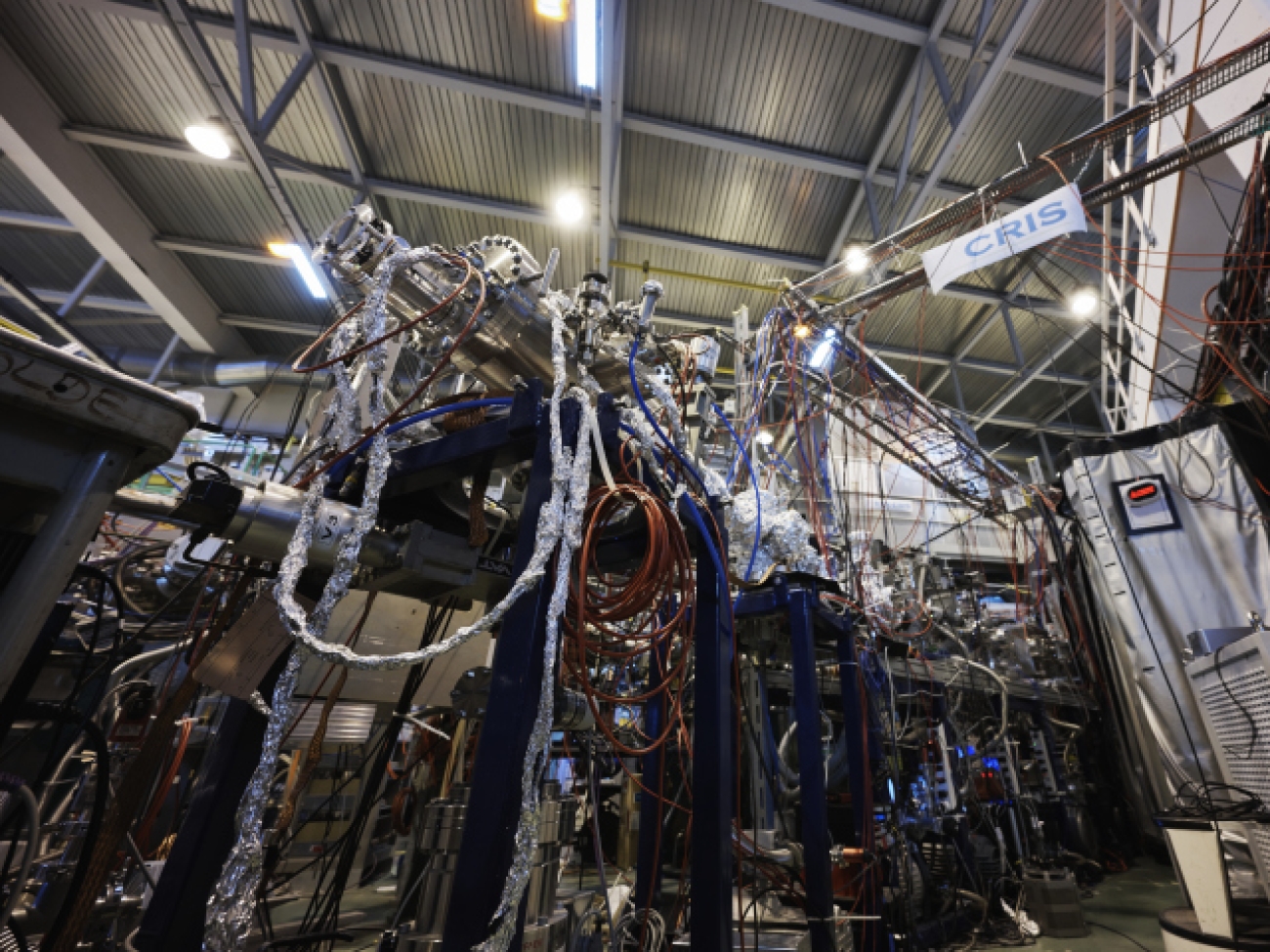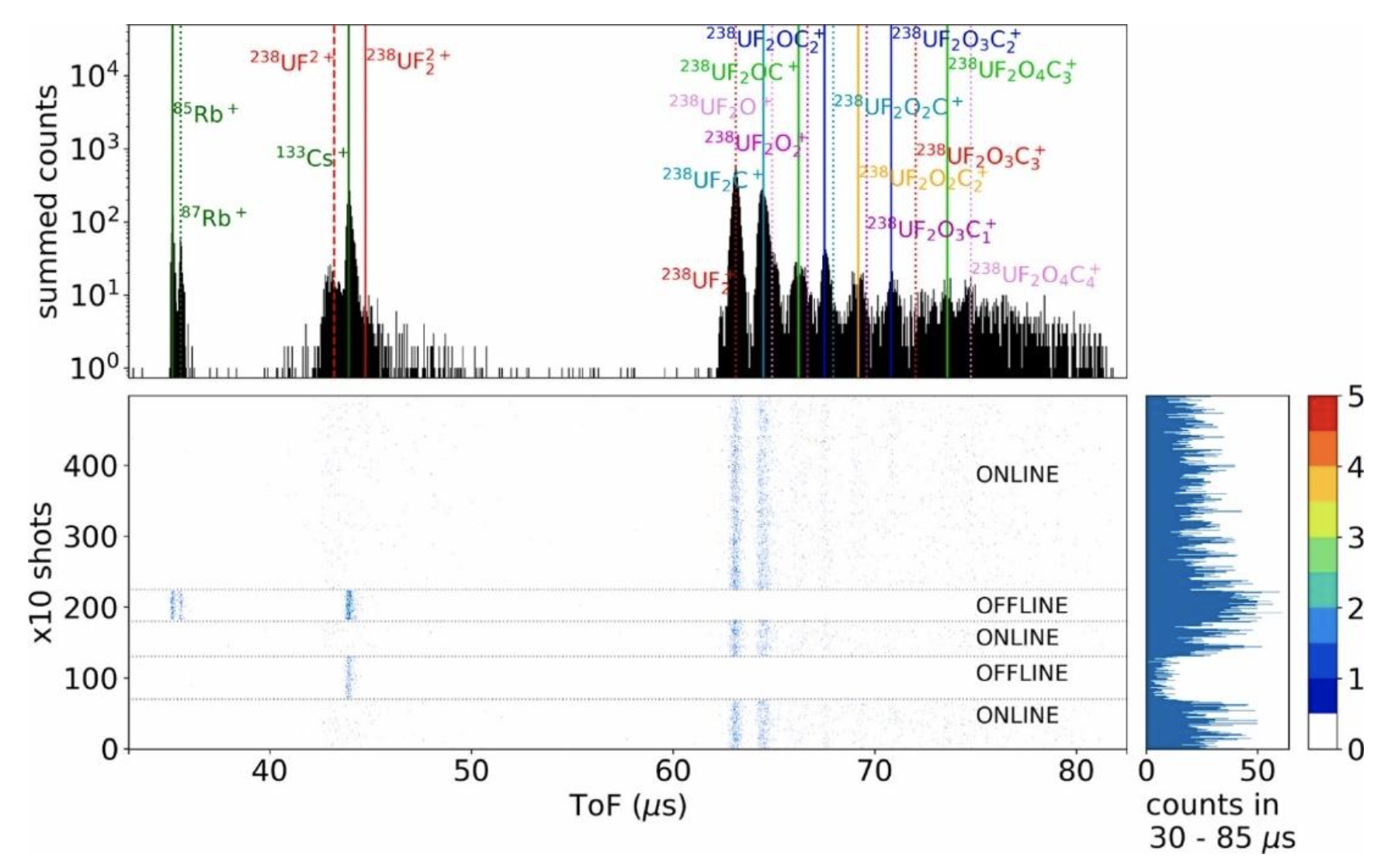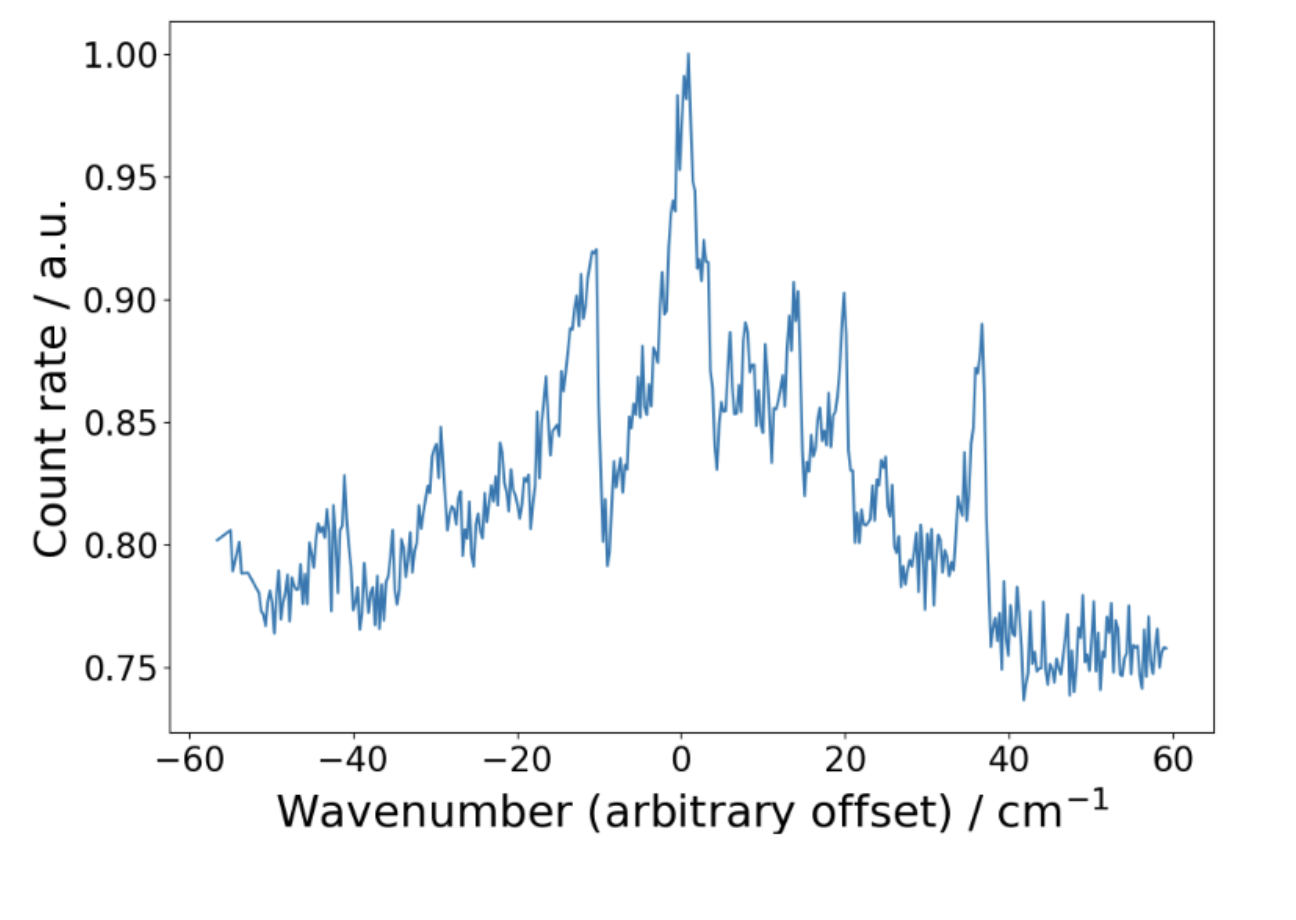ISOLDE lays the ground for CP violation tests with radioactive molecules

All atoms heavier than bismuth, which has 83 protons, are radioactive and their isotopes have short half-lives, with few exceptions. As a result, the study of heavy atoms and their molecular compounds is complicated by the radioactive decay of the nuclei, which presents a risk of ionizing radiation and a question of supply.
The study of radioactive atoms “on-line” – meaning that they are studied within milliseconds of being produced – was revolutionized with the founding of the ISOLDE facility at CERN in 1967 [1]. Dozens of similar radioactive ion beam (RIB) facilities are now in operation worldwide, discovering a total of more than 3000 weakly bound isotopes and elucidating numerous fascinating nuclear-structure phenomena such as nuclear halos, shape coexistence, and axially asymmetric (pear-like) shapes.
In the past few years, ISOLDE has been the center of another breakthrough; the short-lived radioactive molecules radium monofluoride (RaF) [2] and actinium monofluoride (AcF) [3] have been studied at the Collinear Resonance Ionization Spectroscopy (CRIS) experiment at ISOLDE, marking the first spectroscopic studies of such molecules worldwide. In parallel, extensive development campaigns by ISOLDE’s Target and Ion Source Development (TISD) team and the ISOLTRAP experiment have successfully produced and identified tens of other radioactive molecules that are ready for study at CERN.
The importance of radioactive molecules lies in their electronic structure, which has been recognized in the past decade for its far-reaching promise as a probe of time-reversal (T) violation at mass scales comparable to the projected reach of the Future Circular Collider [4,5]. The key is in their strong internal electric fields, which enable sensitive searches for the elusive electric dipole moment of the electron (eEDM) using tabletop experiments [6].
The observation of an eEDM in the laboratory frame can only arise due to T violation – or, equivalently, the violation of simultaneous charge-conjugation and parity, CP. As such, the Standard Model (SM) prediction of the eEDM is exceptionally small. A successful measurement of the eEDM would thus provide an ideal benchmark for the level of CP violation in the SM and beyond-the-SM (BSM) theories [7].
So far, the most sensitive searches for the eEDM have been performed using non-radioactive molecules [8,9], placing the most stringent upper bounds to date and eliminating several BSM theories based on their eEDM predictions. An absolute measurement, however, is still out of reach. Using molecules that contain the heaviest atoms of the periodic table (which are all radioactive) for these searches can potentially bridge the current gap in sensitivity.
The short half-lives of the most radioactive molecules of interest, however, require their “on-line” study at a facility like ISOLDE, and the associated technical challenges have thus obstructed obtaining any experimental information until recently. In 2018, as the last ISOLDE experiment before LS2, the CRIS experiment successfully performed laser spectroscopy of RaF [2], which had long been proposed for its sensitivity to the eEDM and the suitability of its electronic structure for precision experiments [10]. The CRIS collaboration studied its low-lying electronic and vibrational structure (Fig. 1), confirmed its suitability for direct laser cooling [2], and discovered a strong sensitivity of its electronic transitions to the charge radius of the radium nucleus [11].

Figure 1. First spectra of RaF obtained using the CRIS experiment at ISOLDE. Appears in Garcia Ruiz et al., Nature 581, 396–400 (2020). Reproduced with permission from the authors.
This first experiment generated momentum in the experimental study of radioactive molecules. In 2021, RaF was revisited by CRIS using narrowband lasers, allowing to resolve its rotational structure to propose a potential laser-cooling scheme [12], studying its high-lying electronic states, its ionization potential, and first measurements of its hyperfine structure (manuscripts in preparation).
With the impetus of these studies, a wider program on radioactive molecules has commenced at ISOLDE, as the role of radioactive molecules in unique multidisciplinary studies is now recognized worldwide [13,14]. A cornerstone of the program is the development of new techniques to produce and identify radioactive molecules. ISOLDE’s ISOLTRAP experiment features a multi-reflection time-of-flight mass spectrometer (MR-TOF MS) [15] that provides a reliable and precise means for identifying the different molecular species, as shown in Fig. 2.

Figure 2. Example time-of-flight spectrum of the ISOLTRAP MR-TOF MS, identifying uranium compounds formed from molecular ions delivered by the ISOLDE facility. Appears in Au et al., NIM B 541, 375-379 (2023). Reproduced with permission from the authors.
The power of the synergy between ISOLDE’s experimental and technical teams is exemplified in the case of AcF. The ionization potential of AcF is greater than that of RaF and lies beyond the capabilities of the conventional ISOLDE surface ion source that was previously used for RaF. Consequently, an electron arc discharge ion source was developed by the ISOLDE TISD team to ionize radioactive fluorides with a high ionization potential. The production of AcF and the absence of all contamination were confirmed using the ISOLTRAP MR-TOF MS before being sent to the CRIS experiment for spectroscopy. In November 2022, the CRIS experiment thus expanded its activities with the first study of AcF [3] (Fig. 3), which has been proposed as a unique probe for a permanent nuclear electric dipole moment, through the study of what is known as the nuclear Schiff moment.

Figure 3. First spectrum of an electronic transition in AcF obtained with broadband laser spectroscopy at the CRIS experiment.
Future molecular studies are envisioned at ISOLDE using the CRIS experiment and more. Following ISOLDE’s steps, other RIB facilities around the world, such as FRIB (USA) and TRIUMF (Canada), are seeking to initiate programs on radioactive molecules as well.
References
[1] M. J. G. Borge and B. Jonson, Journal of Physics G: Nuclear and Particle Physics 44, 44011 (2017).
[2] R. F. Garcia Ruiz et al., Nature 581, 396 (2020).
[3] M. Athanasakis-Kaklamanakis et al., Laser Ionization Spectroscopy of AcF (2021), CERN-INTC-2021-053; INTC-P-615.
[4] M. S. Safronova et al., Rev Mod Phys 90, (2018).
[5] M. Benedikt and F. Zimmermann, Nature Reviews Physics 1, 238 (2019).
[6] D. DeMille, J. M. Doyle, and A. O. Sushkov, Science (1979) 357, 990 (2017).
[7] C. Cesarotti et al., Journal of High Energy Physics 2019, (2019).
[8] V. Andreev et al., Nature 562, 355 (2018).
[9] T. S. Roussy et al., ArXiv 2212.11841, (2022).
[10] T. A. Isaev, S. Hoekstra, and R. Berger, Phys Rev A 82, 1 (2010).
[11] S. M. Udrescu et al., Phys Rev Lett 127, 033001 (2021).
[12] S. M. Udrescu et al., Under review (2023).
[13] M. Athanasakis et al., Radioactive Molecules at ISOLDE (2021).
[14] G. Arrowsmith-Kron et al., ArXiv 2302.02165, (2023).
[15] R. N. Wolf et al., Int J Mass Spectrom 349–350, 123 (2013).
